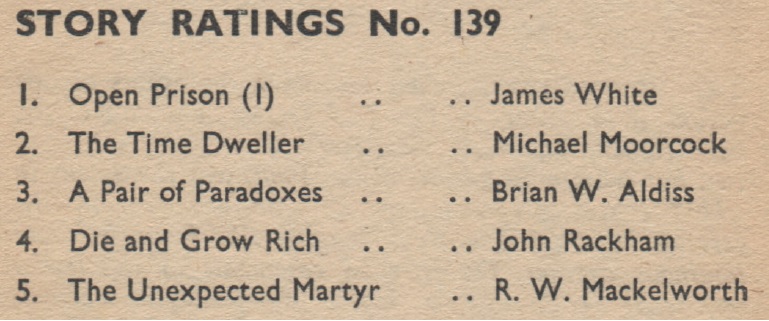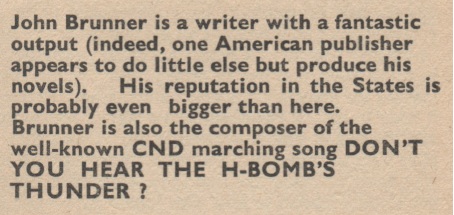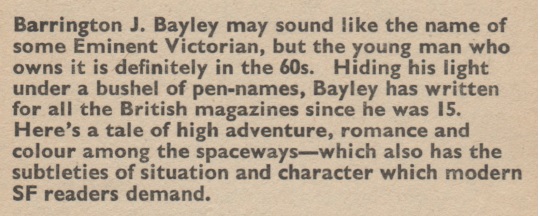
by Mark Yon
Scenes from England
Hello again!
I’m back to New Worlds this month on its new bi-monthly schedule. Getting an issue every other month is taking a bit of getting used to, if I’m honest – I was so used to receiving a monthly issue – but I must admit I’m liking the changes. Perhaps waiting that bit longer has sharpened my appetite?
The issue at hand

by James Cawthorn
The July-August 1964 issue of New Worlds starts with another eye-catching cover by Michael Moorcock’s friend Jim Cawthorn. Like the one in May, it draws you in and makes you want to read it, which does the job it is intended to do. (Although, as I will say later, there is some dissent in the Letters pages.)
To the stories themselves.
Hang on – where’s the rest of The Star Virus, by Barrington J. Bailey? Last issue I thought that there was going to be a second part. However, it seems I was wrong. Apologies for the misunderstanding on my part. (please take another point off the rating)
The Fall of Frenchy Steiner, by Hilary Bailey
I said last month that the ‘new’ New Worlds seems to want to merge the old clichés of s-f with the new sensibility of the so-called New Wave. The title story is one of those, in that the idea of alternate history is not a new one for s-f, but here it is given a new energy and perhaps grittier realism.
Told through the enigmatic and moody “Lowry”, it is a story of what happens to Frenchy Steiner, a German bar singer with psi-powers in an alternate Britain in 1954 run by the victorious Germans. Expectedly, it is a setting full of grimness, all rationing, power shortages and curfews, with the Germans keeping control through propaganda and a strict regime. As well as a pub entertainer, Frenchy leads a double life, as we find out about her familial connections to the Third Reich and her importance to the Fuhrer.
The story starts slowly but builds a credible impression of England under occupation. However, by the end it moves a little too quickly towards its resolution and there’s a few plot points that lack the thought of the initial set-up.
If you are a long-time reader, you may recognise the author’s name. We have met work by Hilary Bailey before, with Breakdown in the October 1963 issue of New Worlds. Breakdown was odd and a little underwhelming for me, but Frenchy Steiner, in a longer novella format, worked much better for me, even though I felt at the end that it could have been better paced. Despite the slight whiff of nepotism (Hilary is also the wife of Mr. Moorcock) this was a great start to the issue. 4 out of 5.
Storm-Water Tunnel, by Langdon Jones
A new writer with his debut here at New Worlds, Langdon is described by the story’s banner as ‘a musician’ as well as a writer. Storm-Water Tunnel is a time travel story using the Moebius strip idea – you know, the one where time is a continuous journey that twists back upon itself. This is a story that does that, but the reasons for it doing so are not clear and so it remains an intriguing trifle. I can see why editor Moorcock likes this one, as it covers similar ideas shown in his writing. As an attempt to be different, it’s OK. I suspect that we’ll see more of this writer in later issues. 3 out of 5.
Goodbye, Miranda, by Michael Moorcock
And so, after a story by the wife of the editor and a story by a friend of the editor, we now have a story by the editor. The banner at the top claims that Goodbye, Miranda is a story about ignorance and the consequences of ignorance. To me it was an experimental piece that just reminded me of a bad Shakespearean tragedy where everyone dies at the end. Based on this, Mike needs to stick to editing rather than writing, at the moment. Awful. 2 out of 5.
Single Combat, by Joseph Green
And here is the return of one of the ‘old guard’, from the older version of New Worlds! We last read Joseph’s work in the July 1963 New Worlds with the so-so Refuge. Single Combat is the story of a fight between a King and a pretender to the throne on a world where the people are seven feet tall. The main difference is that in addition to the physical battle psi-powers are used, which means that most of the story takes place in the participant’s heads.
It is interesting to see how the old style New Worlds writer stands up to the reinvigorated aims of the new New Worlds. The answer is not particularly well, frankly. Away from the psi-powers angle story, the story’s a mass of clichés. The tribes are clearly modelled on the coloured peoples of Africa and the twist in the tale is that – gasp – one of the combatants is a woman. I’m less convinced myself by this old sheep in new clothing persona given to the author myself, but the editor seems to like his work a lot. This is on a par with the ‘old stuff’, so, unsurprisingly, it gets a 3 out of 5 from me.

The Evidence, by Lee Harding
And from one of the old familiars to another. Next is the return of another writer, that of Lee Harding, last seen in the August 1963 issue of New Worlds. The Evidence is described as a “moral tale in the vein of Kafka or Peake”. These are rather lofty ambitions which the story fails to reach, although it is a good try. It’s very paranoid in nature but makes its minor point that whoever uses thermonuclear weapons in warfare must eventually be brought to trial. 3 out of 5.
Miscellany
We then have some letters! One of the advantages of being bi-monthly is that you can have responses in the next issue about the one just read. So, we have comments about Ballard’s story Equinox, concluded this month, and opinions given on the new style New Worlds, but at the same time there’s also the valid point that serial stories may not be good for the new magazine when the issues are two months apart. At least we have a range of perspectives and the views are not all positive, which I think is a healthy position to take. But again, I noticed that there are letters from Jim Cawthorn and John Brunner, which suggests that Moorcock is relying on his friends a great deal. Nevertheless, Brunner’s comment on Brian Aldiss’s mathematical gaffe in his story last month is gently amusing.
The Editorial that follows – again, an unusual placing in the issue – is a report on the British Science Fiction Association Convention of 1964. As I wasn’t able to attend myself, it’s an interesting read on the state of the genre in Britain and a nice overview of the way things are changing in fandom at the moment, but I do suspect that the report is a rather sanitised version of proceedings and doesn’t entirely cover all of the high jinks usually experienced at such events. Nevertheless it is heartening to read that there seems to be an influx of new younger attendees, whilst at the same time an award was given to New World’s retiring editor John Carnell. Do such matters translate to readers in the US, I wonder? I’m not sure. But I guess we may find out, in that one piece of good news in there was the announcement that the 1965 Worldcon may be held in London.
I’m also very pleased to see the return of the book review column, reviewed by someone new, James Colvin. (But actually, it is not new. James is a pseudonym used by both Michael Moorcock and Barrington J. Bayley.)
It is divided into British publications and US publications. In the British part this month we have under the spotlight Gunner Cade by Cyril Judd, otherwise known as Cyril Kornbluth and Judith Merrill, and a non-fiction book named Science: The Glorious Entertainment by Jacques Barzun.
There’s also two paperbacks reviewed covering similar non-fictional themes – Arthur C Clarke’s Profiles of the Future and the perhaps lesser known Inventing the Future by Dennis Gabor.
In the US section there’s Budrys’s Inferno by (strangely enough) Algis Budrys, You Will Never Be the Same by Cordwainer Smith and lastly an Ace Double, The Dragon Masters and The Five Gold Bands by Jack Vance.
Equinox, by J. G. Ballard
In the first part of this story we followed Dr. Sanders on his mission to find his friend Suzanne Clair who had sent him an odd letter and then disappeared into the Cameroun jungle. Much of this part is about Dr. Sanders’ time at the town of Mont Royale on the border between the jungle and the jungle turning into crystal.
The descriptions of the things that have turned into crystal are vivid and imaginative but there’s little else to the story. The plot, such as it is, seems to mainly involve lots of walking and running about by Dr. Sanders through the crystalline landscape in search of his friends.
Whilst Sanders does this there are a number of characters that we also revisit. Generally, the characters seem rather unpleasant, aggressive or sad, though whether this is because of their own nature or as a result of the crystals is unclear.
It helps that we now get an explanation of the cause of the crystallisation, as the physical effect of the combination of our timestream and anti-time, although it is not really rooted in sensible science. Really, Equinox is all about the mystery and strangeness of the landscape and in this the story succeeds, whilst simultaneously showing Ballard’s melancholic obsession with change and decay. If the story’s purpose is to weird out the reader, then it succeeds admirably. Even if I’m still not entirely sure what it’s all about. 4 out of 5.
Summing up
With the second issue of this “magazine of the Space Age”, we are starting to get a better idea of this brave new vision for New Worlds. We have a mixture of the old-style s-f combined with the new, to keep the old readers but also entice new ones. I still get the sense that the editor is finding his feet and seems to be mainly determined to shock and confuse, but he does seem to be confident in what he’s doing, even if he’s resorting to using those that he knows to create a creditable issue.
This seems to be the right way forward. There was a letter in the issue this month that seems rather telling – the correspondent has said that they had bought the last copy of issue 142 from their newsagent, which had not been the case for a long while during the Carnell era. I hope that it is so.
I do feel that there is a change that is new and exciting, even when it doesn’t quite meet its aspirations. Compared with New Worlds of a year ago, the magazine is good.
On this new schedule the next issue will be out at the end of August. Until next time…

[Come join us at Portal 55, Galactic Journey's real-time lounge! Talk about your favorite SFF, chat with the Traveler and co., relax, sit a spell…]

![[June 28, 1964] Not Quite What You Think. ( <i>New Worlds, July-August 1964</i>)](https://i0.wp.com/galacticjourney.org/wordpress/wp-content/uploads/2019/06/640628cover.jpg?resize=563%2C372)

![[April 28, 1964] Out With the Old…. (<i>New Worlds, May-June 1964</i>)](https://i0.wp.com/galacticjourney.org/wordpress/wp-content/uploads/2019/04/640428cover.jpg?resize=555%2C372)






